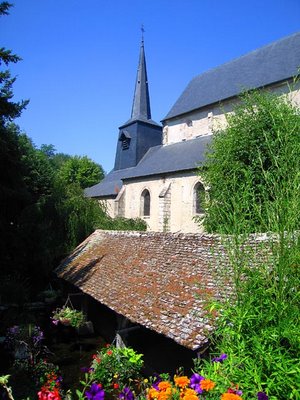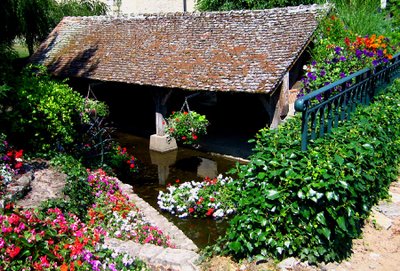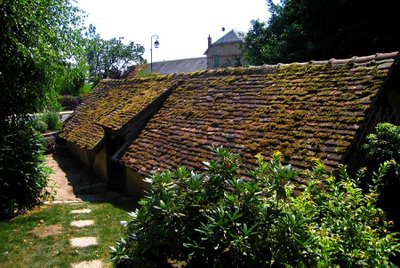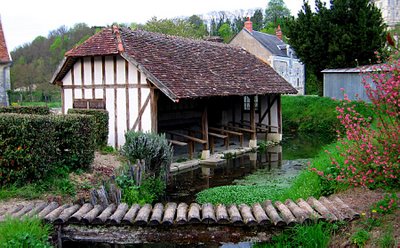But no, Marthe had spotted a lavoir, an old wash house. I don't even remember what village we were passing through. It might have been Boiscommun. Or Courcelles. For a minute just now I thought I had found it on the web in Sury-aux-Bois, but now I'm not sure. Anyway, it's in a village just west of Bellegarde and just north of Combreux. I'll have to go look for it again the next time I'm in that area. Maybe CHM will remember.
A lavoir is a wash house. It's where people went to wash their clothes and linens in the days before washing machines (which is not really that long ago). Usually a lavoir is a covered structure built on the banks of a river, stream, or canal. Women (who undoubtedly did by far most if not all of the laundry) carried their dirty clothing and linens as well as the necessary equipment down to the lavoir on laundry day. Remember, houses had no running water. There was a well, and maybe a pump. There was no electricity.
I found a long description on a web site in French. Here's my translation:
Before I take you back to the years between 1946 and 1950, which is when I had the experiences I'm going to tell you about, doing the laundry, you have to remember that back then there were no disposable paper products. Everything was cloth. No throw-away paper tissues or paper towels. Absolutely everything had to be washed, even cleaning rags. And there were no mechanical devices to do laundry; it all had to be done by hand. As a result, people put on clean clothes just once a week — that's just the way it was. On Sunday, the members of the household changed their clothes, taking off the dirty ones they had worn for seven days, including the men's shirts that had soaked up all the sweat of the hard labor required of them in those days.
That said — young women, listen carefully — it took two or three full days of work to get the laundry done. I loved laundry days, myself. The day before, my grandmother would sort the dirty laundry, thrown into a pile or sometimes put up to hang in an outbuilding for weeks on end so it wouldn't get moldy. It's true. We had enough clothes to get us through. Grandma put the whites — all the household linens were white — into a big tub that we filled with water, hauling it by the bucketful from the well, and threw in two or three big handfuls of soda crystals. That was called soaking the laundry. And then there were what we called Grandpa's "Russian socks" — they were rags that he wrapped his feet in and wore inside his big old workboots. They stank to high heaven. Grandpa said they were good enough for everyday wear. If he said so...
The site goes on with details. The laundry had to be rinsed in the stream to remove the worst of the dirt. Then it had to be boiled in a big metal washtub over a fire. Then it had to be rinsed and hung out to dry. Clothes, sheets, towels, handkerchiefs, rags... it took a lot of time and was hard work.
My mother has told me that when she was a girl in the 1930s and 1940s laundry day was Monday at her house and she had to do a good part of the work. By the time I was coming along in the 1950s, people had washing machines — the kind with wringers at first, more recognizable ones later. But Ma still did a good amount of laundry in the bathtub on a washboard.
Most villages in France have a public lavoir like the one in these pictures. Most of them aren't so dolled up, of course. Around here, there's one in Montrésor, south of us, and one in Choussy, to the north. If there is still one in Saint-Aignan, or in the neighboring villages of Mareuil and Seigy, I haven't found it yet. Then again, there is a new laundromat in town.
And then there's this lavoir in the town of Châteauvieux, just southeast of Saint-Aignan. My friend Marie will recognize it, and I dedicate this topic to her today... She knows why.








Love this lavoir, Ken! I remember your pointing out the one at Montresor. The roof tops remind me of our covered bridges. I bet washing clothes in the lavoir was quite a social event for the women when they gathered there.
ReplyDeleteI think Monday is a good day for doing wash, but I usually try and wash clothes on Thursday. I always do laundry before and after a trip, but like to put off ironing until I'm desperate.
I actually saw an old woman--all dressed in black--using a lavoir in Aosta, Italy in 1997. I watched her for quite a while out of the window of my small hotel.
ReplyDeleteChris P
Merci pour le clin d'oeil :-) !!!
ReplyDeleteCe lavoir était superbe et les gens qui habitaient en face, adorables ! Te souvient-il de toutes les explications érudites données à propos du château de Châteauvieux par ce gentil petit vieux aux yeux bleus tout pétillants ;-) !!! Bises. Marie
Heu, au fait, ce clin d'oeil, c'est en raison des tonnes de linge que ma machine à laver ingurgite depuis hier, suite au retour de vacances et à la flemmingite aiguë de mon fils de 23 ans qui n'est pas fichu de "faire sa lessive", lol ???!!! Bon, si tu as une chemise à laver, tu peux me l'envoyer par Colissimo, na ;-) !!! Re-bises. Marie
ReplyDeleteMarie, si je t'envoie une chemise, est-ce que tu la repasseras aussi?
ReplyDelete;^)
Oui, parce que c'est... TOI, lol ! Bises. Marie
ReplyDeleteInteresting post with great photos to go along with it. Very nice!
ReplyDeleteHi Dennis, did the woman look like somebody who might be on a camping trip?
ReplyDelete